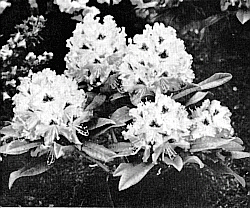QBARS - v20n4 Raising Rhododendrons in Atlanta, Georgia
A Few Comments About Raising Rhododendrons
In Atlanta, Georgia
S. Chris Early, Atlanta, Ga.
One of my interests has been to develop a type of rhododendron which would survive and flourish in our climate.
It can generally be said that as you move northerly and westerly away from the ocean and over the continental United States, temperature extremes become more pronounced. This holds true until you cross the high mountains of the West and reach the northwestern shore.
There one finds an ideal climate for rhododendrons, largely affected by water, forming an ecological system similar to that of England, the Mecca of rhododendrons. By contrast the Southeast has an ecological system similar to that of China. For this reason many of the plants that do so well here are indigenous to that part of the world. Since Atlanta has a 1000 ft. altitude, camellia and Indica azalea buds do not survive some winters. When these cold spells do occur, we could certainly be compensated by a fine type of rhododendrons blooming in the spring.
Many of the present varieties of rhododendrons are susceptible to Phytophthora or an infection that causes them to wilt slowly and die. I believe that this organism is often present in the soil but its spread is related to the temperature and moisture level. Since we have a longer period of high temperature, the incidence level is probably higher. I have noticed that Mr. Charlie Dewey, a successful rhododendron grower in Charlotte, N. C., is careful about too much watering during periods of high temperature.
My experience to date seems to indicate that those rhododendrons with parentage from the Ponticum, Fortunei and Griersonianum series offer the greatest promise for our area.
Although R. catawbiense would normally be considered as the best parent to fulfill all kinds of resistance requirements, it does poorly in Atlanta when brought out of our own Georgia mountains. I have even tried a strain of catawbiense I discovered along the Little River Canyon in Northeast Alabama. Because of conditions there, it has propagated itself for generations by underground stolons and layering caused by flooding. Some qualifications can be made for this species by mentioning a beautiful strain grown by Mr. Eugene Cline at his showplace in the foothills of Cherokee County, thirty miles north of here.
R. maximum , being almost indigenous, seems to thrive here with little care. It grows in immense thickets up in the mountains.
The Carolinianum series that extends from the lower mountains down the Chattahoochee to the Gulf Coast does well in certain areas but I doubt that there are many other lepidotes that would improve it as a hybrid for our area.
The Japanese Ponticum rhododendrons should offer us great promise. I have some crosses of the Chinese Ponticum - R. adenopodum .
I am not too sure about the Caucasicum subseries nor the species R. ponticum as parents for our area; here again the ecological origin is different from China and Japan but not as different as the climate of the Himalayas.

|
|
Fig. 70 'Blue Ensign' exhibited by H.
L. Larson of Tacoma at the Annual Meeting Show in Tacoma. Photo by Cecil Smith |
Although my experience is limited I have gotten good results with the following plants. The old Catawbiense hybrids are quite satisfactory but for newer varieties I have chosen 'Caroline', 'Vulcan', 'Jean Marie de Montague', 'Damozel', 'Doncaster', 'Cary Ann', 'Blue Ensign', 'Mrs. E. C. Sterling', 'Faggeter's Favorite', 'Van nes Sensation', 'A. Bedford', and 'Mrs. A. T. de la Mare'. Many of the Dutch hybrids are good but they need some size before they can compare with the Griersonianum hybrids for blooming. This is a trait we need to improve as there is a tendency here for plants to bloom more conservatively.
I am very impressed with Mr. Gable's hybrid 'Caroline'. The register says this might be a cross between brachycarpum and decorum . This seems logical as 'Caroline' has an extensive root system which is somewhat indicative of brachycarpum . It is interesting to note that brachycarpum is one of the few rhododendrons growing in Korea, the most northerly and extreme climate in the Asiatic rhododendron belt. Here in Atlanta we need a more extensive root system to penetrate the clay and cushion against the weather extremes. The root system must nourish 'Caroline' better, as it is leafy and well formed in contrast to some of the other plants. 'Caroline' would probably be an excellent under stock for the yellow and more difficult varieties of rhododendrons in our area. I have seen excellent plants of 'Blue Peter' grafted on maximum .
R. decorum as the other parent of 'Caroline' does seem to be one of the best species for our area although it is a bit tender for some locations. R. fortunei and discolor are excellent but seem to be shy blooming as small plants. R. griffithianum and griersonianum are excellent parents but must be kept in a conservatory due to their tenderness.
R. griersonianum , although a rather unshapely parent does impart excellent blooming characteristics and some immunity to dry weather. 'Vulcan', a griersonianum hybrid is no doubt the best modern hybrid for the Southeast. A plant I have on some property near Highlands, N.C., has endured 8 below zero. I have crosses of 'Caroline' with griersonianum , decorum and 'Vulcan'; although small, they look promising.
